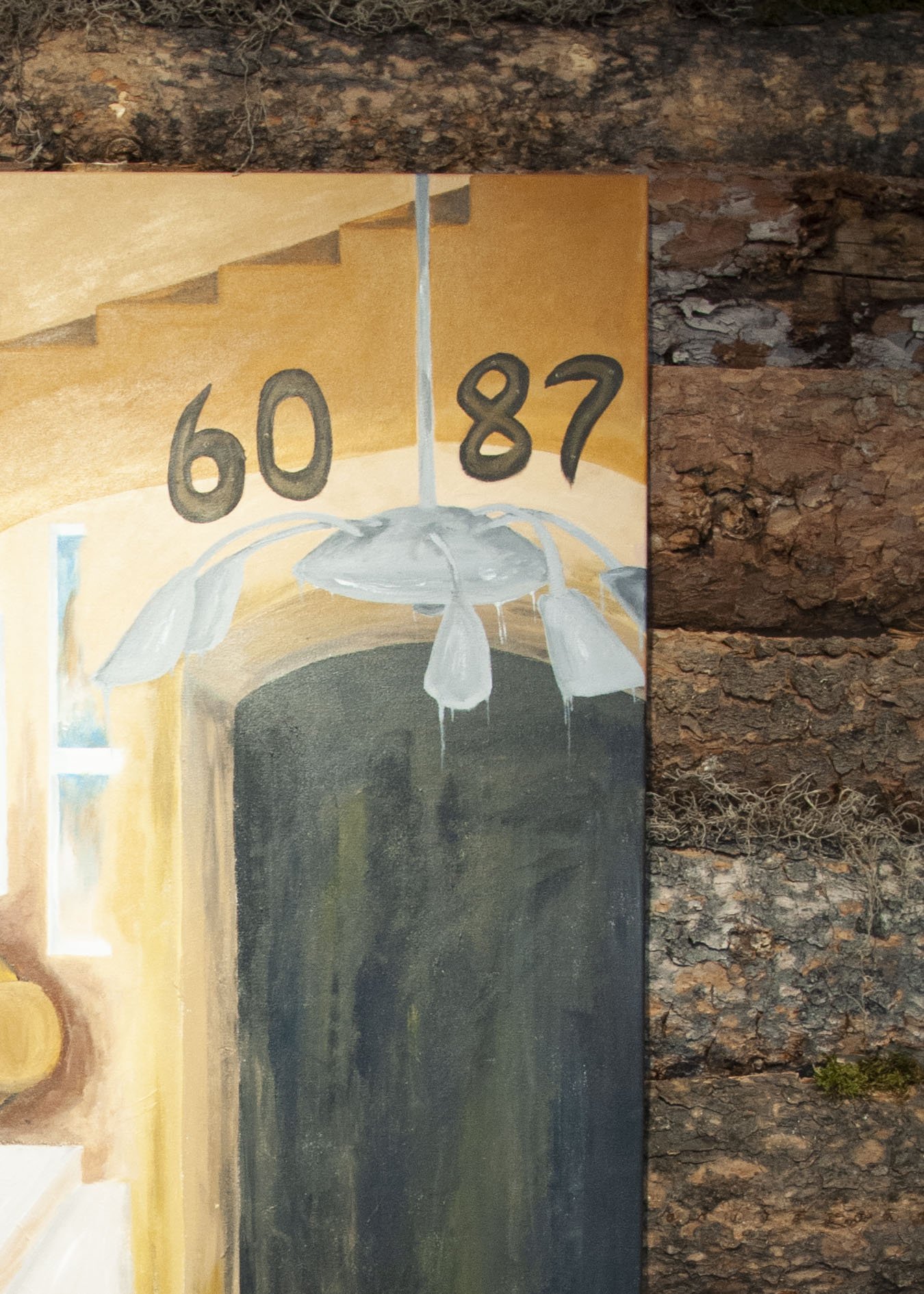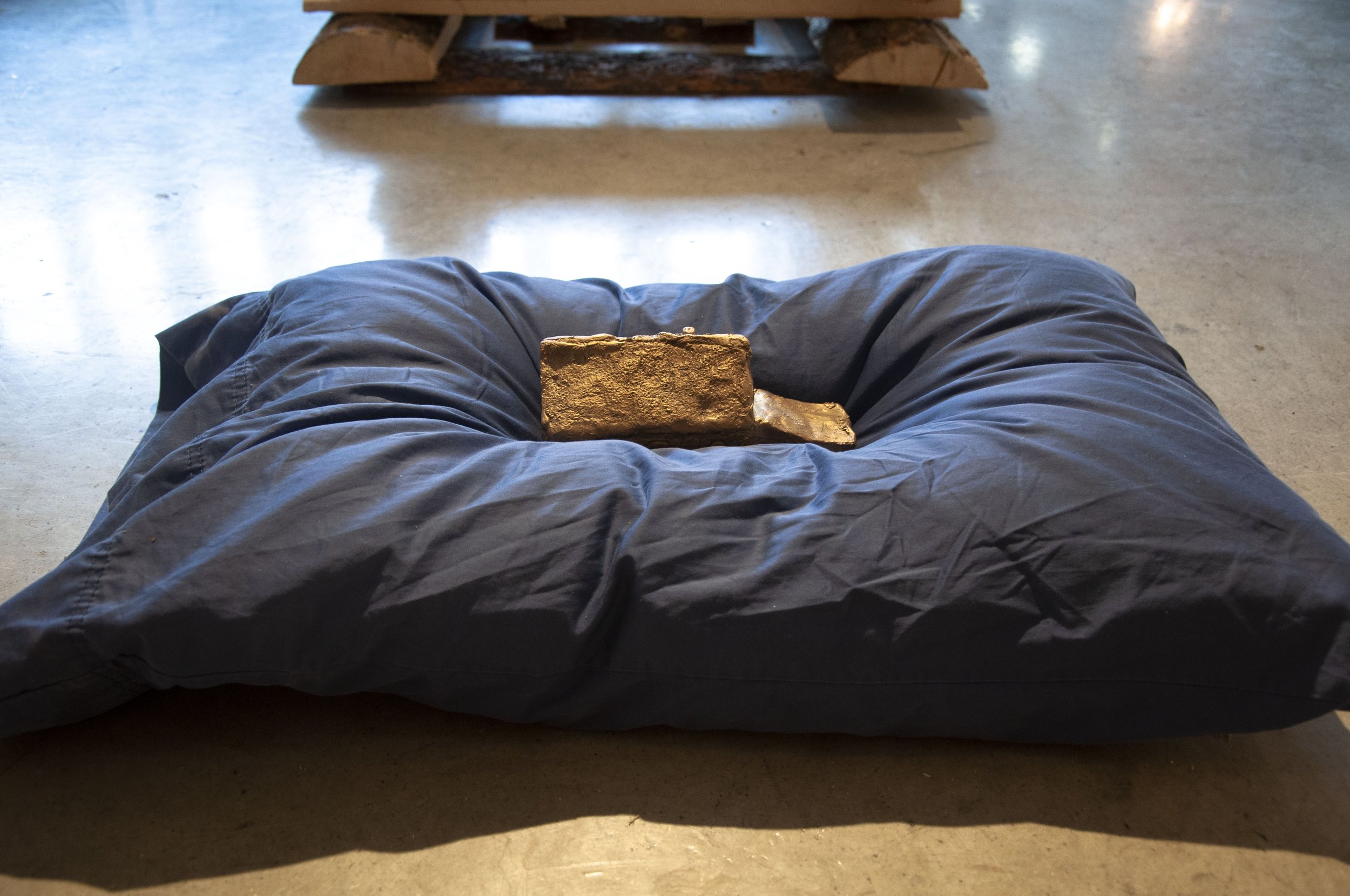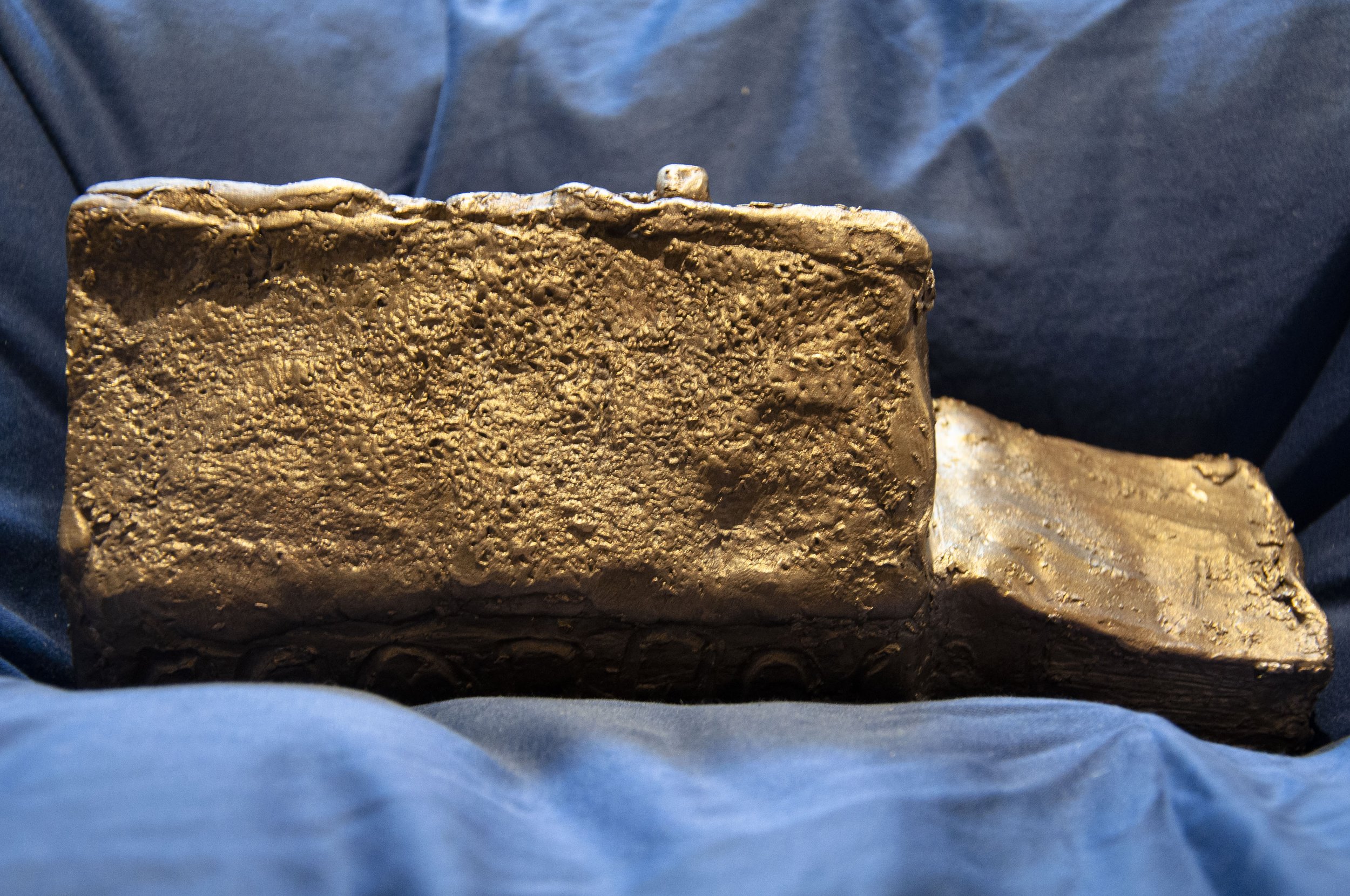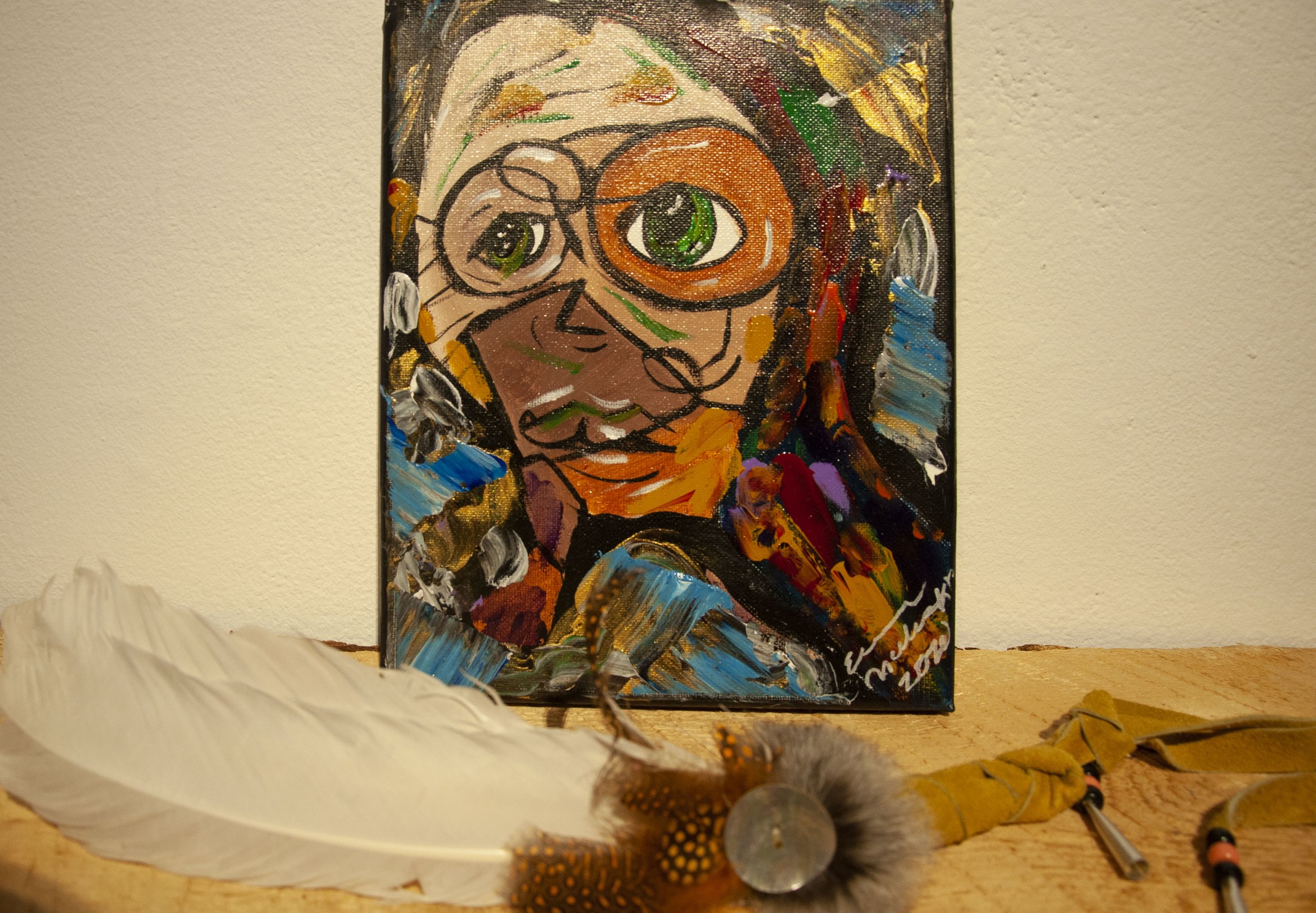The Winter Lodge /
In collaboration with
aahwaatkamooksi peer mentors
01.04.2023
/ 01.20.2023



The Winter Lodge exhibition is an Indigenous space that embodies the spirit of the communal lodge found in traditional ways of being. Varied artistic practices and engagement sessions activate the gallery through community-focused narratives that explore rich histories, bright futures and the complex now. The exhibition aims to provide an Indigenous-led platform for racialized and ally artists to foster a sense of connection and understanding, while engaging in the curatorial process.
Weathering the cold together, we invite you to immerse yourself in the stories of these artists through sight, sound, touch and memory.
In order order of appearance as displayed in the gallery.
Brace Grandjambe
Tipi Woman, 2022,
conte on black drawing paper
When creating this piece, I wanted to capture the idea of “home” and the importance of women within my Indigenous culture. Being plains Cree, I am aware of our culture and ways of life. The Tipi is a place of home, a sacred space for many Indigenous peoples. It is built as a team effort, and when raised with elders and other community members it is strongest. With Missing and Murdered Indigenous Women being one of the most heartbreaking ongoing crises, Indigenous women are constantly at risk, afraid to leave home alone. The comfort of home is safer. Despite this, Indigenous women are resilient and strong, bringing these issues to the surface. Their community-strength is stronger than ever, and these women create a sense of home and comfort through actions and words.
Brace Grandjambe is a Plains Cree artist residing in Calgary. Her practice revolves around her own struggle with mental health, generational trauma and discovering her own identity.
Emmanaeve
Andy’s Dream, 2020
acrylic on canvas
During the Covid-19 pandemic, summer of 2020 Em McLuckie was inspired by her great-grandfather Andy Southerland. Andy’s father was chief of the Peguis reserve in Manitoba. Andy was unable to fulfill his next-in-line duties as he was taken away as a young boy to a residential school where he faced assimilation and unspeakable abuse. For many years he was unable to speak of the horrors he faced as a result of the school. Painting an image of her Great-Grandfather based on her gut feelings of his appearance, an image was created of him as a younger boy after Residential Schools. The abstract painting style leaves to ponder his being as he was stripped away of his culture and family so young, he was left to question his identity.
Morgan Black
Not Your Fairy-tale, 2022
wool and wooden dowels
The tipi is not simply a form of housing but embodies sacred teachings unique to many Indigenous cultures. The materials and methods that go into making a tipi are imbued with meanings that require protocols to be shared. I often see large corporations and non-Indigenous people appropriate the imagery of the tipi as cutesy decoration in their children’s bedrooms or for their pets. It hurts to see our cultures and all the sacred meanings they hold reduced to fairy-tale characterization for the amusements of others. I hope to bring awareness to the continued dehumanization of Indigenous peoples and inspire thought and discussion on how we can all decolonize our thoughts and behaviours.
Morgan Black is a Ts’kw’aylaxw First Nations artist and curator residing in Treaty 7 territory whose artistic practice focuses on their Indigenous identity, decolonial practices, and representation that prioritizes respect, autonomy, and inclusivity.


Morgan Black
If she was your daughter, mother, sister, auntie
or grandmother, you would see her, 2022,
Crotched red wool .
The red dress has become a symbol for the Missing and Murdered Indigenous Women, Girls, and 2 Spirit crisis that is afflicting our communities across the continent. The mesh crochet technique conveys the lack of visibility for the MMIWG2S crisis. The garment loses any sense of protection from the gaze and becomes an exposed and hole-ridden substitute. The revealing cut of the dress speaks to the stolen sisters and people who are often targeted for their vulnerability. The unfinished nature of the dress reminds us that the violence is not over, and we need to take action to protect Indigenous people from the brutality perpetrated by both individuals and colonial systems.





Helen Arias
La Muerte y Sus Flores, 2022
acrylic, ink, flower petals,
reflective tiles on canvas
La Muerte y Sus Flores represents the relationship individuals have between nature and death. My view of the current state of this relationship is one of decay, excess, and gluttony. We are in between death and nature and the consequences of our actions causes us to suffer. Despite it, we continue to live with no regard to the future that we will leave for future generations.
Helen Arias is a first-generation Venezuelan immigrant with the privilege to call Mohkinstsis her home. Throughout her work, Helen depicts her fascination with female violence, the macabre, and the cycle of life through colourful and eclectic mixed media paintings. She infuses her adoration of outsider art, flora, ancient mythology to create compositions wholly her own. Her free time is dedicated to becoming a being of pure, unapologetic expression.


Mahek Hussain
Home Sweet Home, 2021
acrylic paint
Home Sweet Home reflects a need for similarities and feeling of belonging outside our homes. Using nostalgic images of my own house around the canvas, the dreamlike space showcases the connection of everything familiar: that one odd spider lamp at my grandparents, the cabinet in my old kitchen, the hallway arch I’ve always walked through, the doorknobs I’ve turned. A home is so much more than just a shared space like an apartment, it’s a place of emotional and spiritual connection. When one’s experiences are alike, it brings a sense of comfort. Where we feel seen and comfortable, that is a home, that is a community.
Born and raised in Calgary, Mahek Hussain is a first-year student majoring in Jewelry and Metals at AUArts. In addition to her craft studies, Hussain has a strong interest in painting. She is particularly interested in incorporating elements of her Pakistani culture and heritage into her pieces and pushing the boundaries of her art.


Emmanaeve
Pîsim’s Bison, 2022
taken on Elk Island with a Nikon
D3500, 18-200mm TAMRON lens, ISO 250,
f/6.3.
Less than 100 Bison were left untouched by the late years within the 1880’s. This was the result of over-hunting by European traders. They hunted them near extinction just as they tried to do with Indigenous people. Over 100 years of forced assimilation, abuse and death, Indigenous peoples of Turtle Island continue to strive and persevere on the land they have called home for thousands of years. “Pîsim’s Bison” is a symbol and representation of perseverance bison and Indigenous culture. While shooting Em witnessed this young bison calf run into a tree quite harshly and shake it off as if nothing happened. Clearly impacted, the young calf continued to walk on his land, turning the soil with his hoofs, his feces returned to the Earth as the vegetation provides energy for him to continue on, his thick hides protect him from the harshest of prairie winters allowing his species survival.




Amara Billo
And They Still Danced, 2022
digital mounted on illustration board
Amara is among many Indigenous people disconnected from their culture due to the injustices of the 60s Scoop. With her family now being passionate card players, she chose to design a potential deck of cards that combines her family’s current interests and their roots. Amara took inspiration from three powwow dances: Grass Dance, Jingle Dance and Fancy Dance.
Amara Billo is a second year Character Design and Illustration student at AUArts. She comes from Prince Albert, Saskatchewan and moved to Calgary to pursue art. Primarily a digital artist, Amara’s passion lies with creating characters and stories to connect with.

May Kineyetums
An Expression of the Bow, 2023
projection
An Expression of the Bow is a performance of the Bow River that I happened to witness and capture on camera. It was a thrilling show; drama, intrigue, a full-tree-sized piece of driftwood.
This was a product of my research on decolonial jewellery, which I’ll tell you about some time, drop me a line.
AJ Kluck
My Grandma's House on My Pillow, 2023
bronze, pillow, 20 x 26 x 8 inches
AJ Kluck (they/them/čniłč) is an interdisciplinary artist living in Mohkínstsis, Treaty 7. Their mother is Irish, and their father is sqilxʷ. AJ’s practice is rooted in building slow and gentle relationships with the land and community, healing inter-generational trauma, processing their identity as a sk̓ʷsk̓ʷtmsqiltk (half-blood) person, and celebrating and reconnecting with sylix ways of being and knowing. Kluck is currently studying Sculpture at Alberta University of the Arts.
This work is a bronze cast of in̓qáqnaʔ iʔ sn̓ʔilítm̓s (my grandma’s house). My grandma’s name is Cecile Alexis, she is my father’s mother. Her house was at the Head of the Lake on the Okanagan Indian Band Reserve (OKIB). We are sqilxʷ (Indigenous). The bronze cast of my grandma’s house is on top of my pillow. I am thinking about the weight and responsibility of honouring your ancestors. Colonization across canada has resulted in genocide. My nation is no different. We have been isolated, removed, killed, and separated. The permanence and strength of bronze speaks to our resiliency as syilx people, and as a monument to my grandma. My father was adopted in the late 1960’s, and she passed before we reconnected. It’s hard for me to not see a relationship between euro-colonialism and the separation of our family, our language, our culture. The coldness and density of the bronze also speaks to the distance I sometimes feel to my culture and people. I do my best to honour all relationships in my life. Everything I know and the good in my life comes from those around me. lim̓lm̓t pisnəqsilxʷ



Thea
Let’s Bingo, 2022
six bingo cards printed on card
stock, readymade bingo set
Thea is Haudenosaunee Kanien’keha:ka from Kahnawake Mohawk Territory. Her art practice is primarily fibre based and strongly influenced by Haudenosaunee art and craft culture. She enjoys fusing culturally traditional elements with contemporary formats as a way to maintain authentic visibility within contemporary spaces. Thea uses beading, sewing, and print design throughout her practice. When being approached with the themes of storytelling and community, Thea wanted to work outside of what she’s used to and produce something that engaged thoughts or memories of community and gathering. In her final body of work Let’s Bingo, she produces six bingo cards, each containing a mixed combination of numbers. The cards are paired with a readymade bingo set intended for the viewers use. Thea intends for this work to initiate engagement amongst viewers and create memories within this space built for community.







